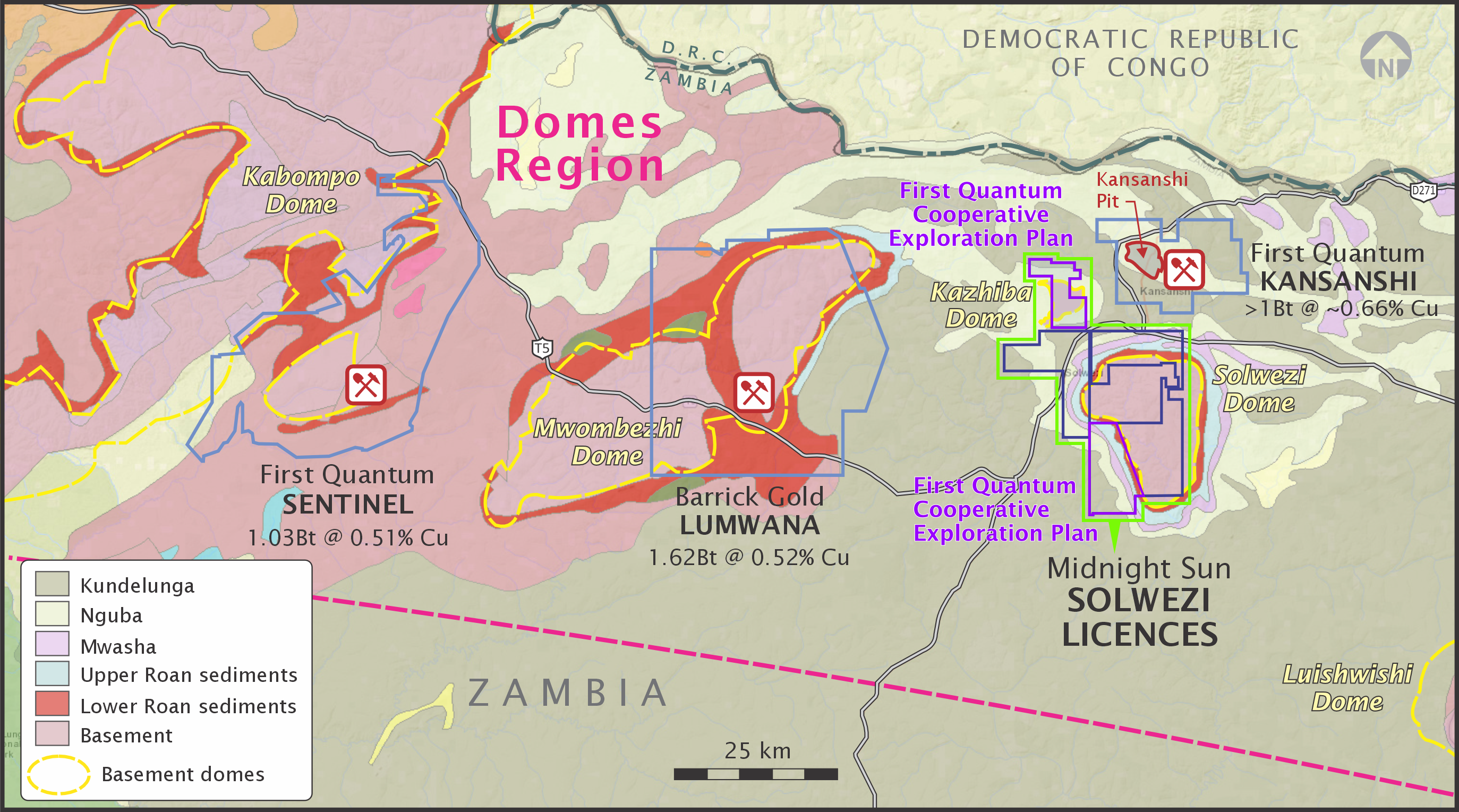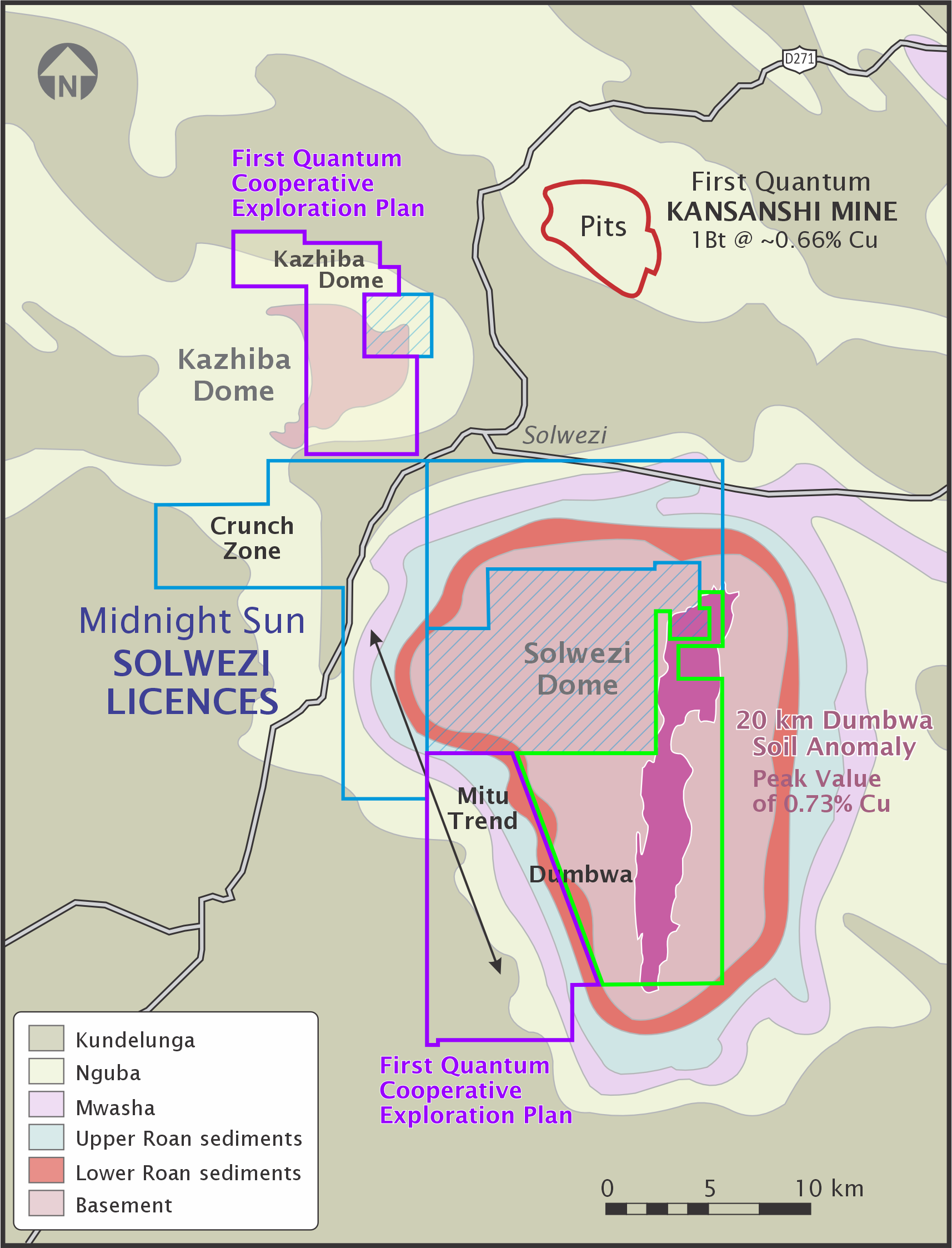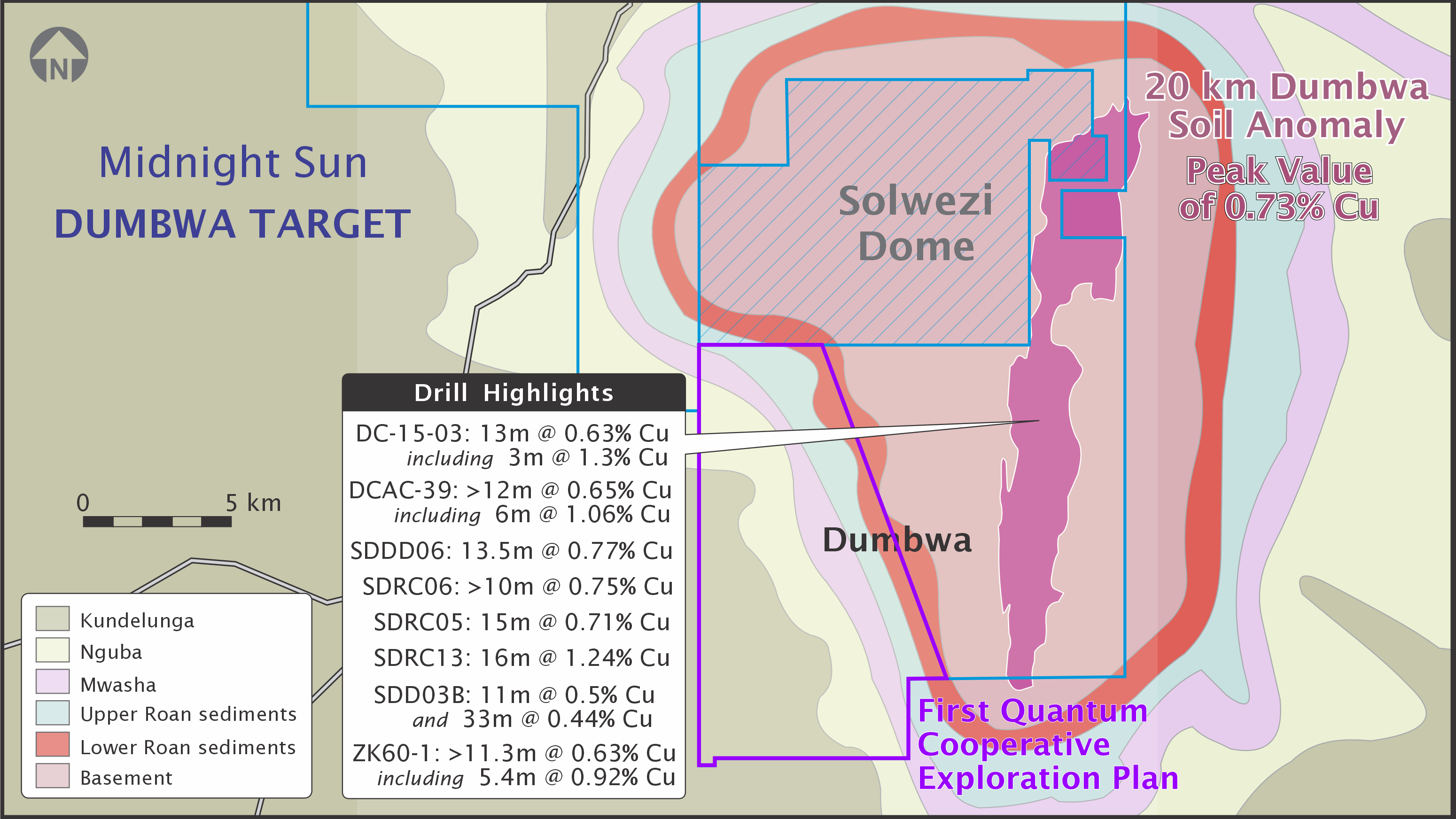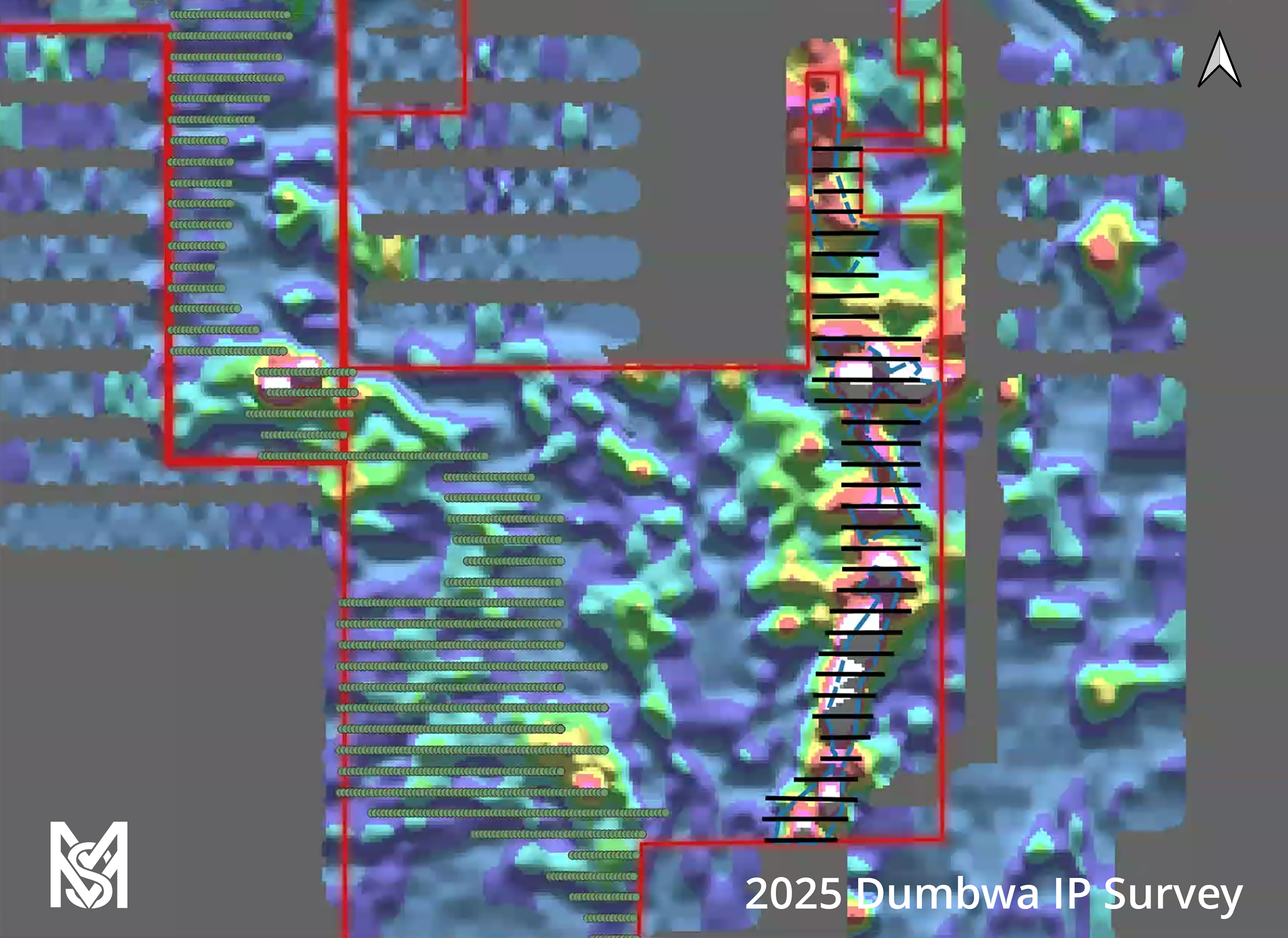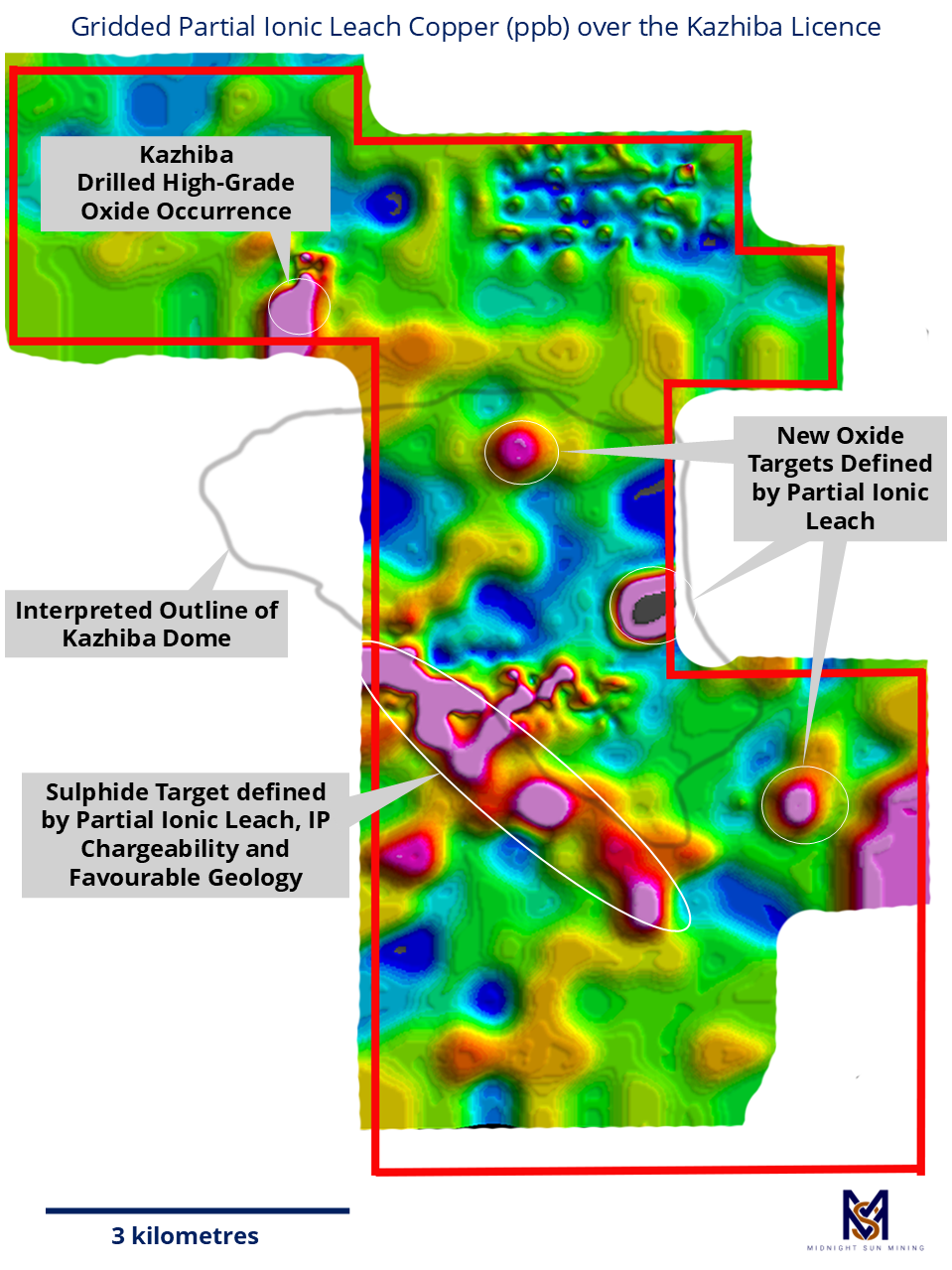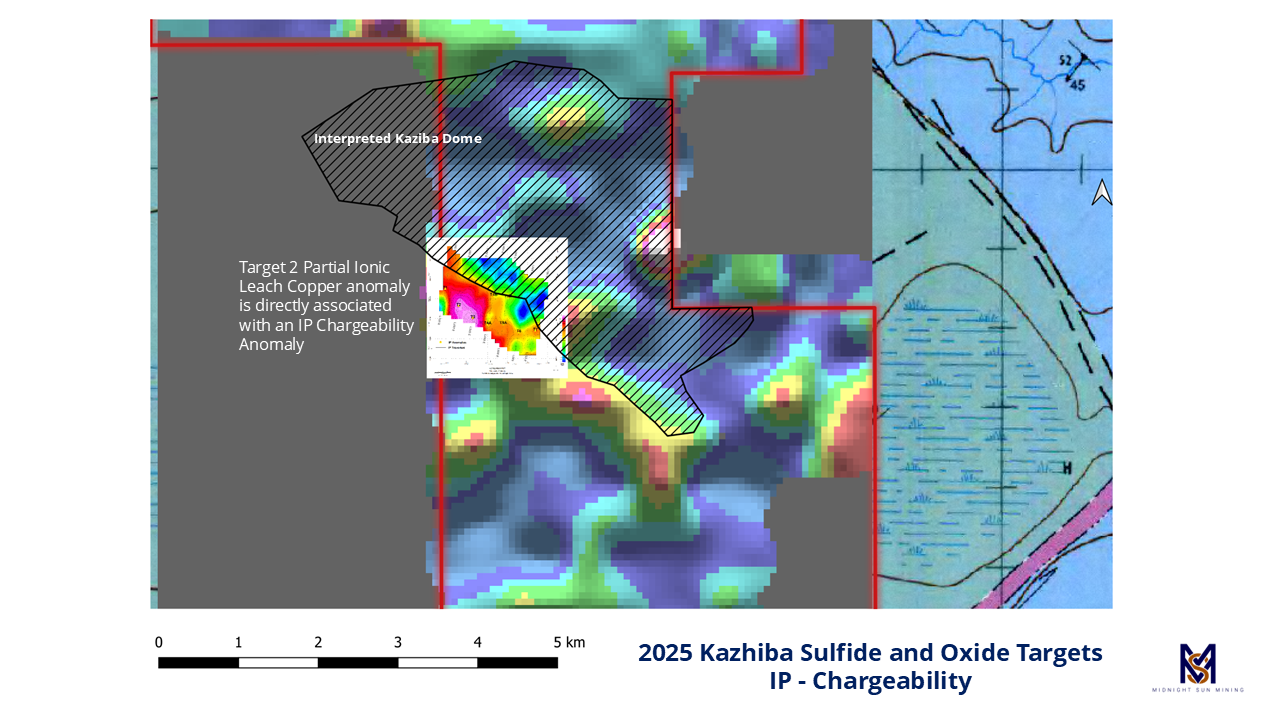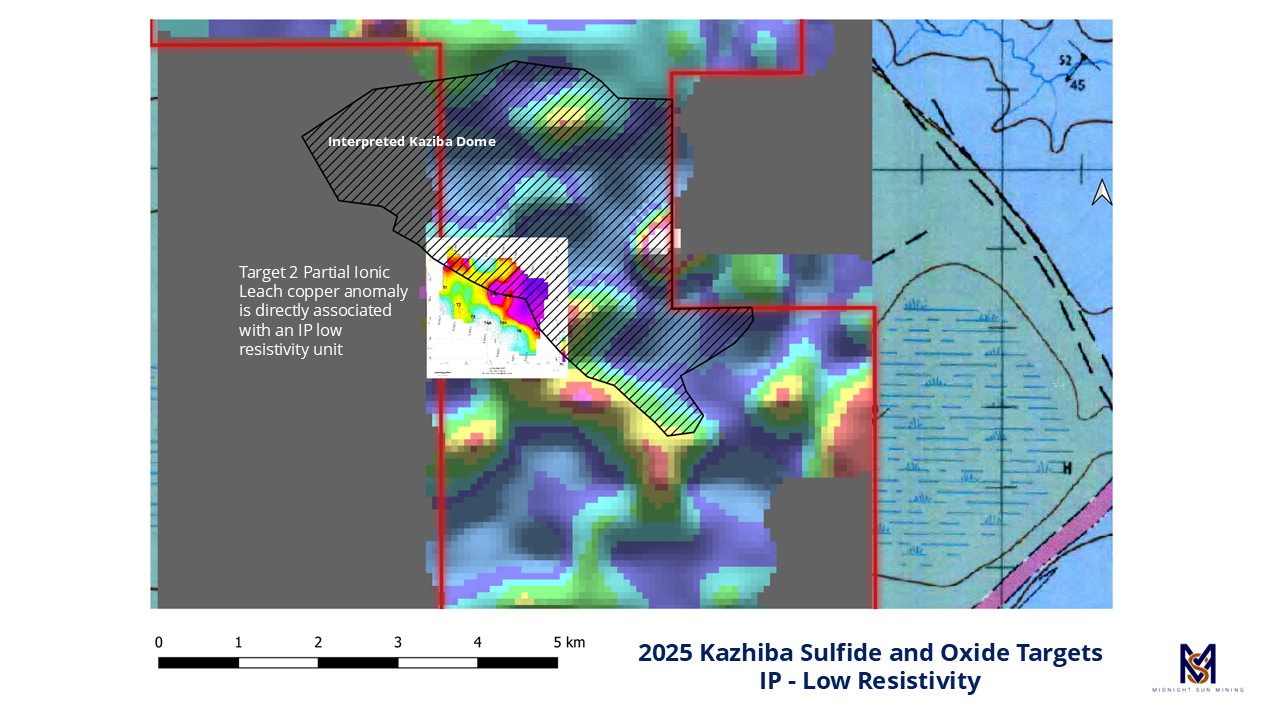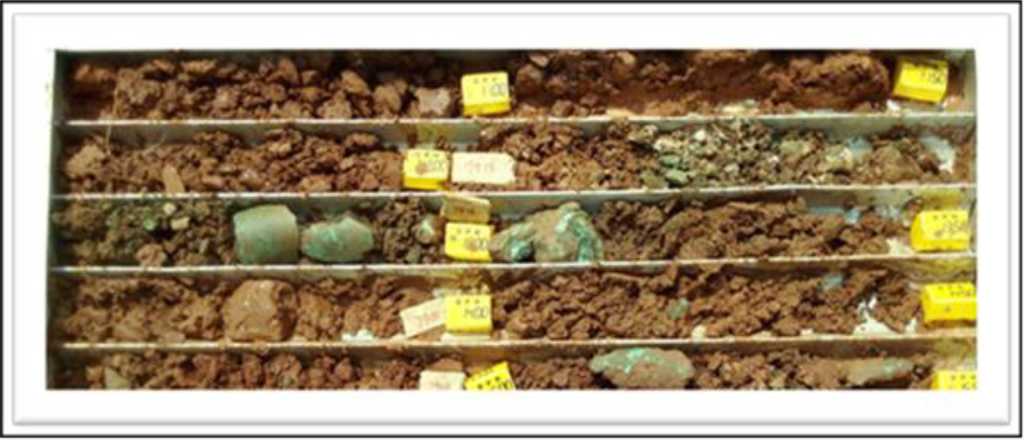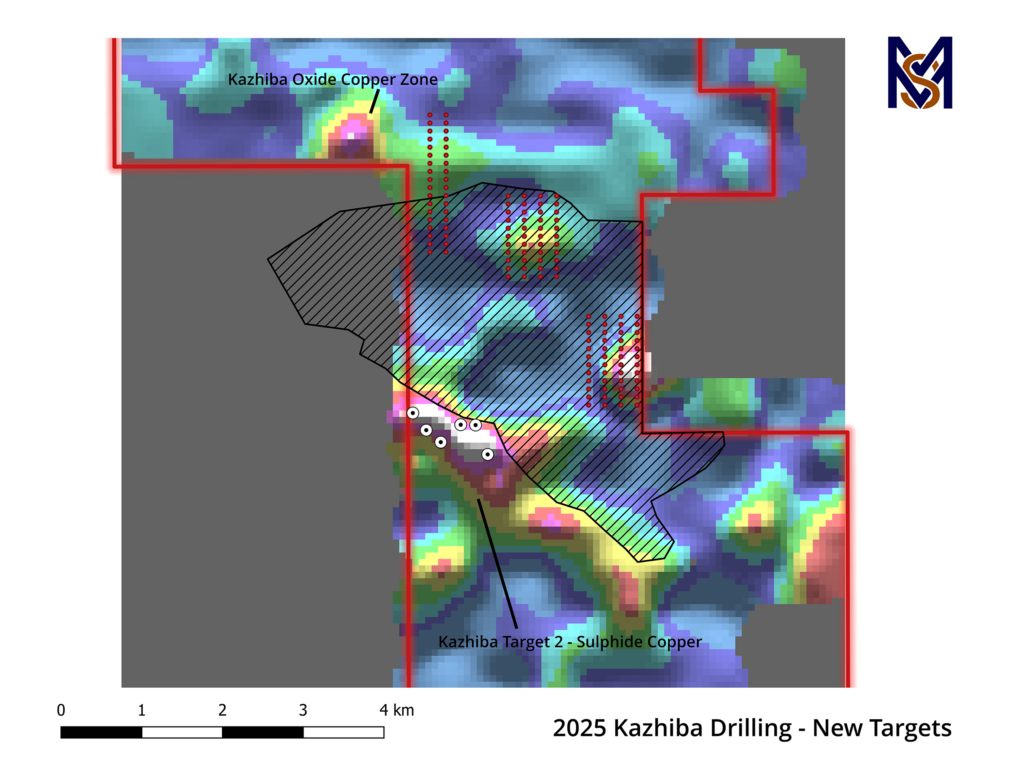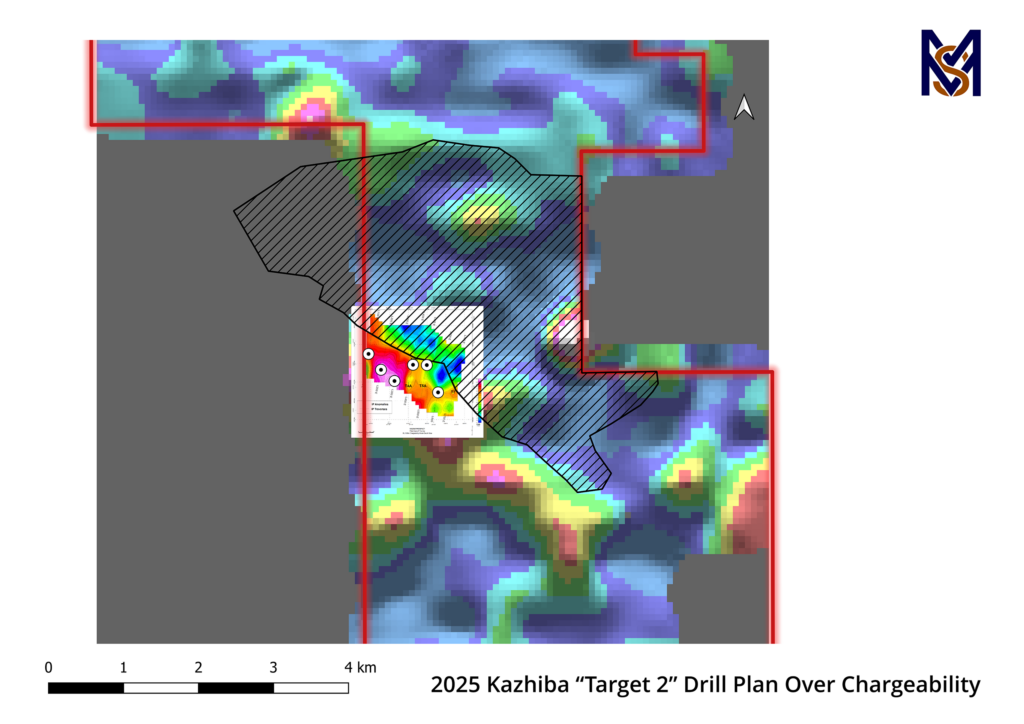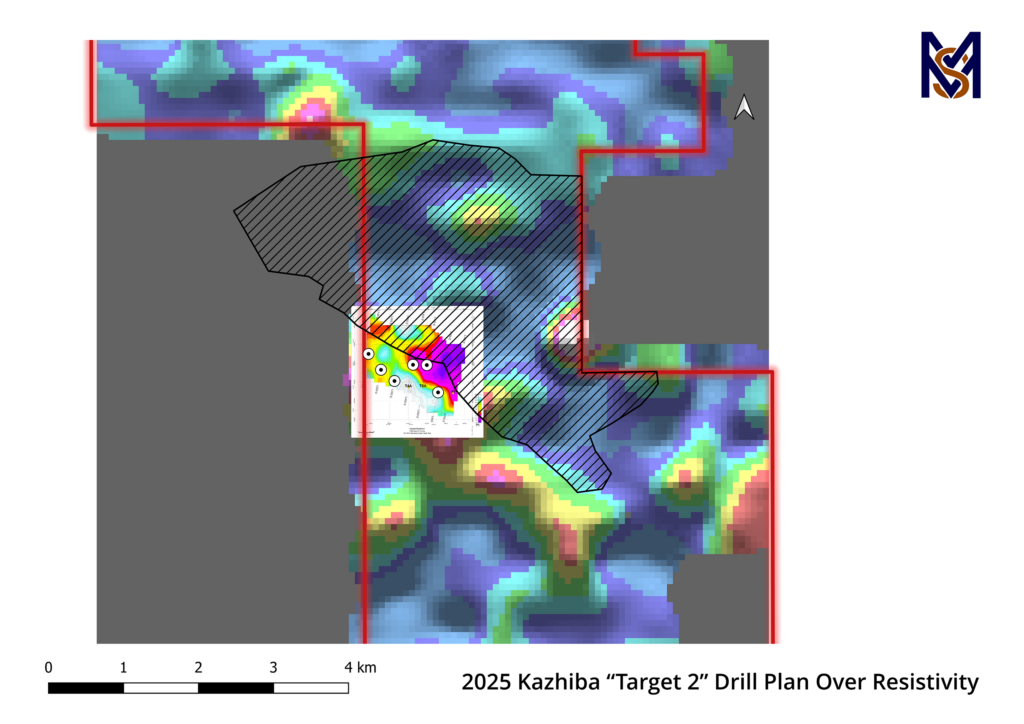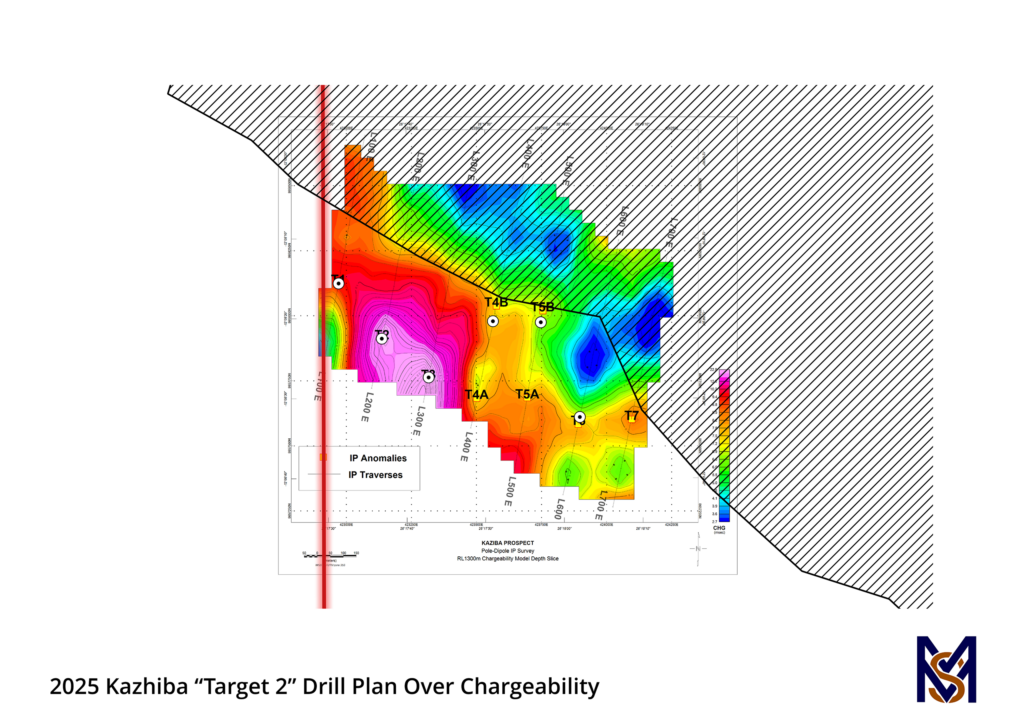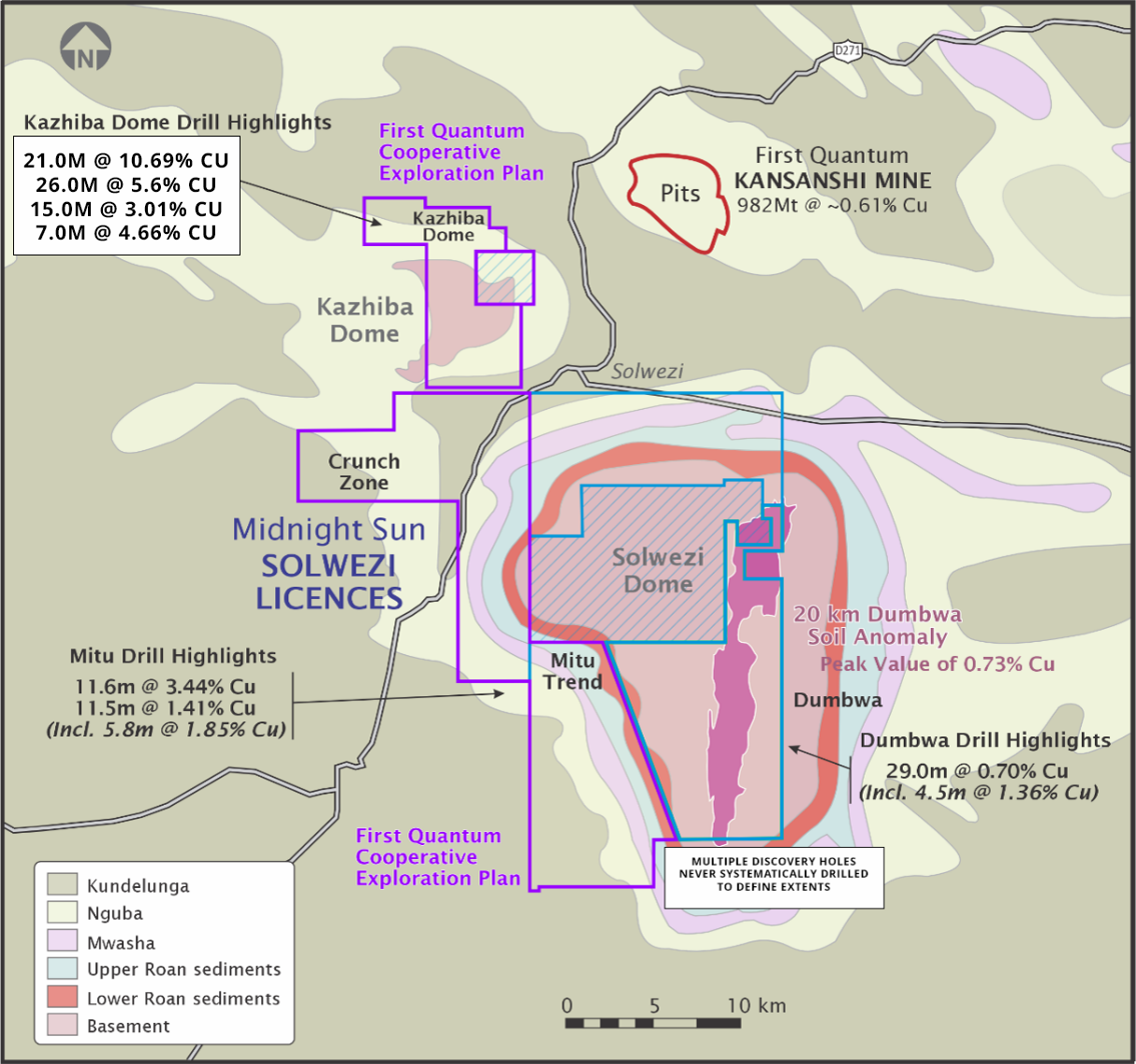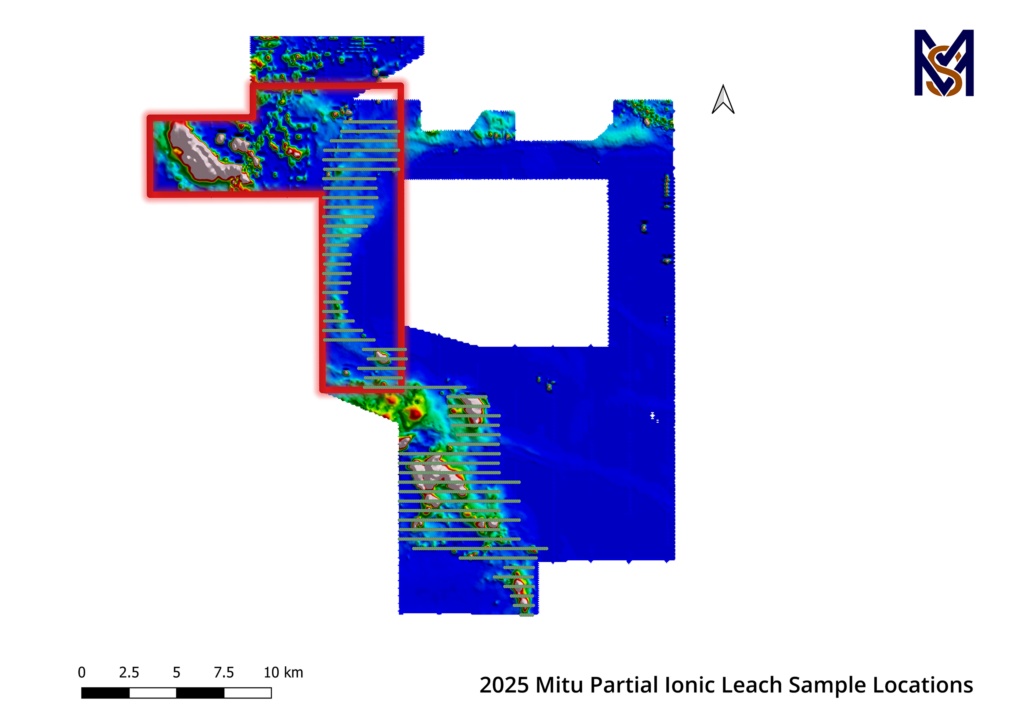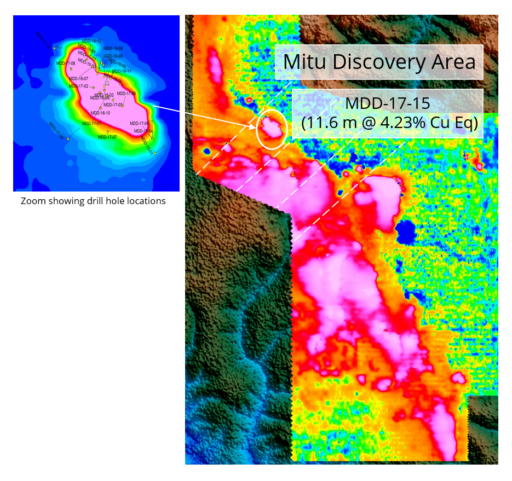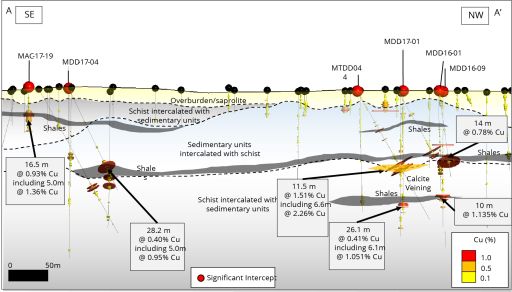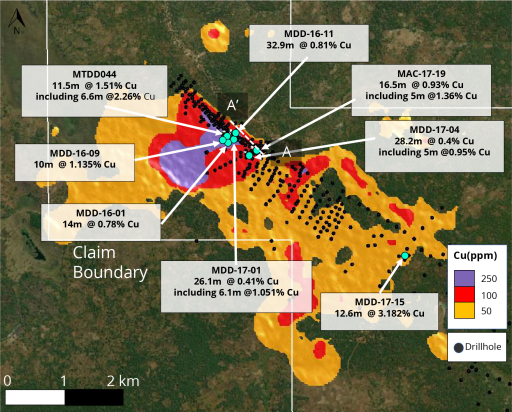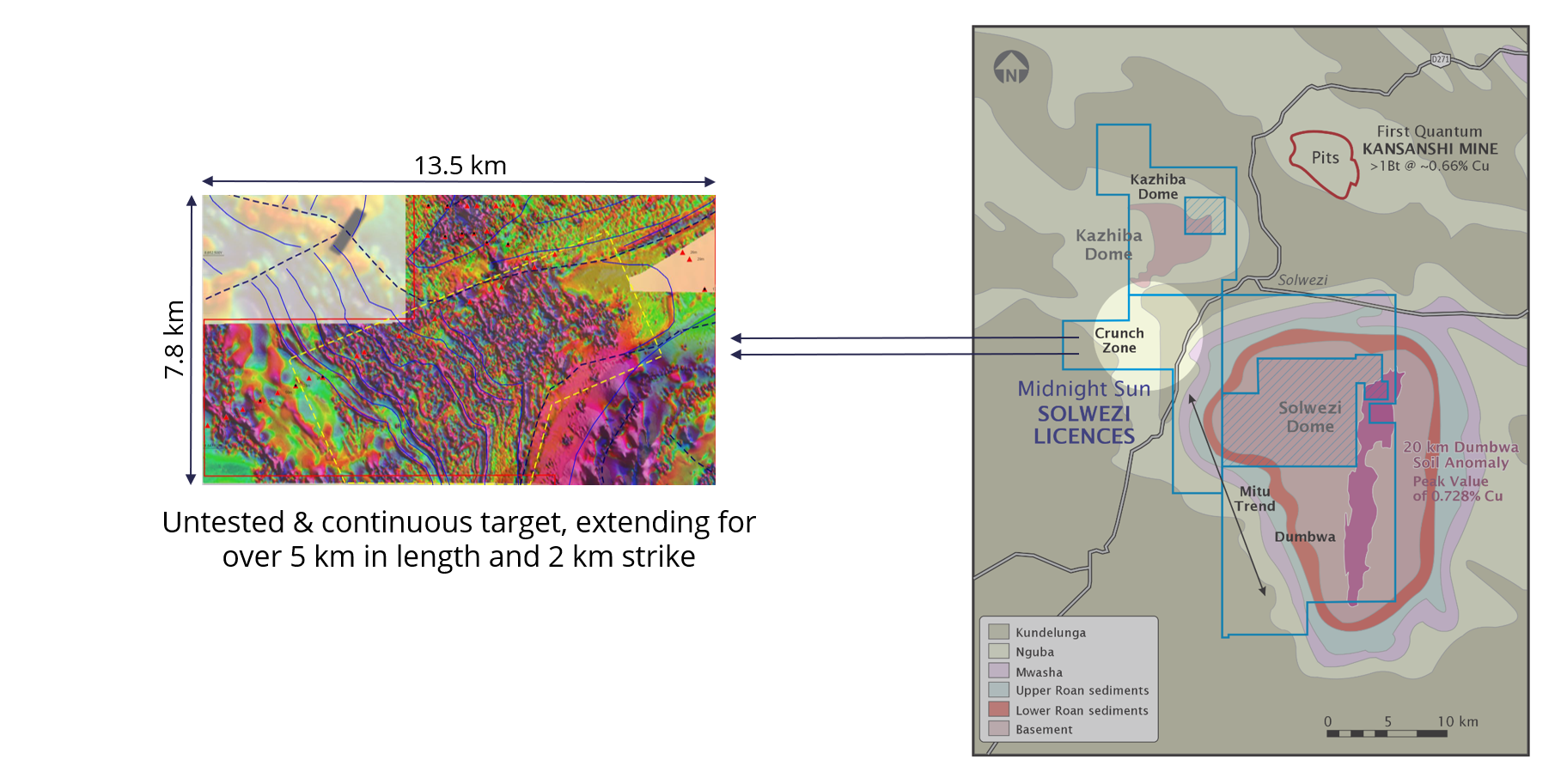Our vast 506 km² property features numerous structural and mineralized targets and our team have made multiple significant discoveries on our property to date. We have identified 4 separate target areas which we believe to host unique geological systems, each with the potential for a significant copper discovery. The targets are Dumbwa, Mitu, Kazhiba (22 Zone) and Crunch Zone. In the case of Dumbwa, we have a remarkable target for the discovery of a transformative sulphide copper deposit. At Kazhiba and Mitu, we are targeting both high-grade near-surface oxide-copper mineralization, as well as deeper and larger sulphide copper targets at depth.
Dumbwa
Dumbwa is a near surface, low-strip, Tier-One exploration opportunity with very similar geology and mineralisation to Barrick’s nearby Lumwana Mine. The target features a remarkable continuous high-grade copper-in-soil anomaly, which extends for over 20 km along strike and +1 km in width, with peak values of up to 0.73% copper. Extensive soil sampling and shallow drilling have established extensive oxide copper potential, while also demonstrating that further drill campaigns guided by structural controls are necessary to establish dip direction, continuity, size, and scale. Our team has discovered multiple stacked mineralized horizons, which we believe are analogous to Barrick’s Lumwana Mine, located just a short distance to the west. It is one of four key prospects that comprise our Solwezi Project.
Ideal targets that have turned into mines in the Zambian Copper Belt, typically feature key characteristics such as a large coherent soil anomaly that is consistent with the ‘right geology’, bedrock exposure close to or at surface, and biological anomalies such as copper clearings. Dumbwa has all these criteria in abundance.
“What initially struck me about the Dumbwa Target was the remarkable similarity to Lumwana. They are both north-south trending, 15 degrees east-dipping schist-hosted mineralised zones and both have multiple, stacked, mineralized horizons. Previous drilling has demonstrated that the copper-in-soil anomaly at Dumbwa is directly tied to bedrock schist-hosted copper sulfide mineralisation. But, by comparison, the geochemical anomaly at Dumbwa tends to have a higher copper tenor at surface and is laterally more extensive than found at Lumwana.” – Dr. Kevin Bonel, COO, Midnight Sun Mining
Dumbwa in detail
Successive campaigns of soil sampling and shallow Air Core drilling have tested oxide copper potential and limited diamond drilling has returned positive results. During 2015 and 2016, 50 air-core and 6 diamond drill holes were completed at Dumbwa. The strong north-south copper anomaly indicates a high degree of structural control with potential cross-cutting fault zones adding to the complexity of the regional geology. Based on the Company’s interpretation and past drill results, Dumbwa is a target worth pursuing at depth.
The Dumbwa mineralization is located within the highly folded and faulted Pre-Katanga Basement rock of the Solwezi Dome. The dominant lithology of the mineralized zone is fine to medium grained quartz biotite muscovite garnet “basement” gneisses that become schistose in localized areas. Surface mineralization is associated with intense potassic alteration of the basement gneisses. Mineralization appears to be structurally controlled and occurs as multiple zones of disseminated and veinlet hosted Cu of hydrothermal origin. Cu mineralization occurs as malachite within the oxidized zone, and chalcopyrite, bornite and minor chalcocite within the sulphidized zone.
2025 Exploration at Dumbwa
Dumbwa is firmly believed to be analogous to Barrick’s nearby Lumwana Mine. Both are north-south trending, 15 degrees east-dipping, bedrock schist-hosted mineralised zones and both have multiple, stacked, mineralized horizons. Previous drilling has already demonstrated that the copper-in-soil anomaly at Dumbwa is directly tied to bedrock schist-hosted copper sulfide mineralisation. But, by comparison, the geochemical anomaly at Dumbwa which runs for~20 kilometres and peaks at 0.73% Cu, tends to have a higher copper tenor at surface and is laterally more extensive than found at Lumwana. We have launched our 2025 Exploration Program at Dumbwa, and Kevin Bonel is utilizing same logical steps employed by his previous team at Lumwana, where they moved that analogous asset from Tier-two to Tier-one status in just 24 months, giving Barrick a world-class 1.62 billion tonne, 0.52% copper deposit.1
As a first step in this methodical and concise approach, we are carrying out an extensive dipole-dipole induced polarization (“IP”) geophysical survey will be utilized to test the 20-kilometre strike extent of the Dumbwa copper-in-soil anomaly, to guide targeted drilling. This drilling will be scheduled to begin following the completion of the IP survey and interpretation of results. The survey is expected to produce an effective picture of the dip direction, depth of targeted geology, and correlation of the geochemical anomaly at surface with sulphide copper mineralization at depth. The survey will have a line spacing of 500 metres with variable lengths from one to two-and-a-half kilometres, for a total of 56 line-kilometres.
Kazhiba
2024 Drill highlights include
Highlights of surface drilling from the Kazhiba Oxide Copper Target include:
- 10.69% copper over 21.0 metres from drill hole MSZ22-028
- 5.60% copper over 26.0 metres from drill hole MSZ22-020
- 3.01% copper over 15.0 metres from drill hole MSZ22-012
- 4.66% copper over 7.0 metres from drill hole MSZ22-030
2022 Drill highlights include
| Hole | True Width (m) | Cu (%) | Co (%) | Ni (%) |
|---|---|---|---|---|
| MTDD044 INCL INCL | 11.50 4.15 5.80 | 1.41 1.29 1.86 | 0.11 0.13 0.07 | 0.03 0.09 0.02 |
| MTDD045 | 7.30 | 0.58 | 0.02 | 0.02 |
| MTDD047 | 26.10 | 0.32 | 0.07 | 0.05 |
| MTDD048 | 22.25 | 0.39 | 0.01 | 0.01 |
Kazhiba, is located 20 kilometers northwest of the Solwezi Dome and is less than 10 kilometres from the western mine gate of First Quantum’s Kansanshi Mine complex. Kazhiba is underlain by a previously undiscovered basement dome similar to those at both Kansanshi and Solwezi. Domes are believed to be associated with the copper mineralization at nearby mines, including both First Quantum’s Kansanshi and Sentinel mines as well as Barrick’s Lumwana Mine.
Mineralization at Kazhiba was discovered by follow up shallow drilling in 2012 over a subtle copper anomaly with thick overburden. The discovery hole intersected 11.3 metres of 5.71% Copper, near surface. Additional intercepts include 21 metres of 3.26% Copper and 6.4 metres of 5.08% Copper.1 Drill campaigns in 2013 (reverse circulation) and 2014 (diamond drilling) extended the high grade, near surface discovery.
In late 2024, Midnight Sun carried out an exploration program which was designed to validate and confirm a potential oxide copper resource at the Kazhiba Target as the first major step under the previously announced Cooperative Exploration Plan with First Quantum Minerals (see news release dated April 23, 2024).
2024 Drill Highlights include: 10.69% Cu over 21 metres, 5.60% Cu over 26 metres, and 3.01% Cu over 15 metres, and 4.66% Cu over 7 metres1, all near surface with very low strip.
The 2024 program established “proof of concept” and defined not only a high grade oxide copper blanket, but a very significant sulphide copper target and several additional oxide copper anomalies, that share a very similar geochemical signature to the known Kazhiba oxide copper occurrence.
Work to date has confirmed that Kazhiba is a strongly variable, near-surface (low strip), unexploited, oxide copper opportunity featuring a high-grade oxide copper blanket, with sulphide targets at depth, waiting to be drilled.
.
Kazhiba in detail
A 2024 program completed on our Kazhiba Target delineated and confirmed a high-grade oxide-copper blanket. The program consisted of RC drilling, IP and Partial Ionic Leach Sampling TM and most importantly established “Proof of Concept” with regards to our plan with First Quantum. Kazhiba is a strongly variable, near-surface (low strip), unexploited, oxide-copper opportunity featuring a high-grade oxide copper blanket.
Drill Highlights from the 2024 program include: 10.69% Cu over 21 metres, 5.60% Cu over 26 metres, and 3.01% Cu over 15 metres, and 4.66% Cu over 7 metres1, all near surface
The program also Identified a north/northeastern extension, as well as a very significant sulphide copper target and several new oxide copper anomalies that share a very similar geochemical signature to the known Kazhiba oxide copper occurrence.
These new targets for exploration work provide room for growth and expansion. Drill results from the 2024 Program will form the initial basis of an internal resource, and follow up drilling is planned to re-start April 2025. Exploration work on Kazhiba is underway now and will be ongoing.
Historical Kazhiba Details:
Kazhiba, which features our high grade 22 Zone, is located 20 kilometers northwest of the Solwezi Dome and is less than 10 kilometres from the western mine gate of First Quantum’s Kansanshi Mine complex. Kazhiba is underlain by a previously undiscovered basement dome similar to those at both Kansanshi and Solwezi. Domes are believed to be associated with the copper mineralization at nearby mines, including both First Quantum’s Kansanshi and Sentinel mines as well as Barrick’s Lumwana Mine.
The 22 Zone was discovered by follow up shallow drilling in 2012 over a subtle copper anomaly with thick overburden. The discovery hole intersected 11.3 metres of 5.71% Copper, near surface. Additional intercepts include 21 metres of 3.26% Copper and 6.4 metres of 5.08% Copper.1 Drill campaigns in 2013 (reverse circulation) and 2014 (diamond drilling) extended the high grade, near surface discovery. Drilling has now confirmed a high-grade copper oxide blanket.
In an attempt to detect the underlying source of the oxide mineralization at the 22 Zone, 6.7 kilometres of NSAMT geophysics was run in the vicinity, and a conductive zone was indicated. To date, this conductive zone has not been drill tested.
It is currently thought that the 22 Zone and environs may be underlain by a basement dome similar to those at Kansanshi and Solwezi. This doming is believed to be intimately associated with the processes resulting in the copper mineralization at those sites.
2024 Drill highlights include
- 10.69% copper over 21.0 metres from drill hole MSZ22-028
- 5.60% copper over 26.0 metres from drill hole MSZ22-020
- 3.01% copper over 15.0 metres from drill hole MSZ22-012
- 4.66% copper over 7.0 metres from drill hole MSZ22-030
Drill highlights include
| Hole | True Width (m) | Cu (%) |
|---|---|---|
| SLZ-13-RC-002 | 21.0 | 3.26 |
| SLZ-14-DD-010 | 11.3 | 5.71 |
| SLZ-14-DD-005 | 6.4 | 5.08 |
| SLZ-14-DD-001 | 4.5 | 6.27 |
Underlain by a previously undiscovered basement dome similar to those at Kansanshi and Solwezi. Domes are believed to be associated with the copper mineralization at each of Kansanshi, Lumwana, and Sentinel.
Kazhiba 2025 Exploration
The results of the recently completed 2024 exploration program at Kazhiba confirmed high-grade oxide copper mineralization in drill intercepts, identified mineralized extensions to the initial oxide copper zone, and highlighted significant new sulphide and oxide copper targets (see news releases dated January 29th, 2025, and February 27, 2025). The 2025 phase one exploration campaign is now underway, and will follow up on the 2024 program, with continued drilling on extensions of the high-grade transported oxide copper blanket and addressing the new geochemical and geophysical targets with a combination of drilling and additional IP lines.
Approximately 4,000 metres of reverse circulation drilling across 125 holes is planned to both follow up on potential extensions of oxide mineralization indicated by the 2024 drill campaign as well as test the three new oxide copper targets identified by Partial Ionic Leach sampling.
Six to eight diamond drill holes totalling approximately 1,000 metres are planned on the recently identified ~four-kilometre by two-kilometre Kazhiba sulphide copper target. This target has demonstrated a significantly elevated copper signature in Partial Ionic Leach testing, coupled with high chargeability / low resistivity responses from IP geophysics, coinciding with a subtle traditional geochemical response, and situated in geology consistent with most deposits within the Zambian Copperbelt. This correlation of key characteristics has led the Company to theorize that this is a very strong target for the discovery of a copper mineralised stratigraphic unit and the potential sulphide source of the transported oxide material discovered on the Kazhiba License.
Mitu
Mitu is a target area located in the southwestern portion of our Solwezi Project. Early exploration at Mitu identified “ore shale” type mineralization on the flank of the Solwezi Dome, crosscut by Kansanshi style veins. A series of near surface Cu-Co-Ni-Au intercepts, identified and confirmed copper-cobalt mineralization, including an impressive drill intercept of 11.6 metres grading 3.44% Copper. Additional drill results included:
- MDD-16-01 – 8.0 m of 1.22% Cu, 0.09% Co, and 0.05% Ni and 14.0 m of 1.02% Cu, 0.03% Co, 0.06% Ni
- MDD-16-06 – 30.3 m of 0.49% Cu, 0.03% Co, and 0.05% Ni and 9.0 m of 0.49% Cu, 0.02% Co, 0.03% Ni
- MDD-16-09 – 9.4 m of 1.03% Cu, 0.14% Co, and 0.04% Ni
- MDD-16-11 – 28 m of 0.82% Cu, 0.03% Co, and 0.05% Ni
The discovery of structurally controlled Kansanshi-style mineralized veins represented an additional mineralizing event in the area and drilling delineated a 1 kilometre by 500 metre zone of mineralization which remains open. A VTEM survey carried out over the target delineated multiple conductive zones, all occurring in favourable geology, over more than 17 kilometres on strike.
Further results from drilling carried out in 2022 confirmed a new and exciting revelation, concluding that copper mineralisation intercepted at Mitu is associated with cobalt, nickel, and anomalous gold. This suite of metals is comparable in mineralization style and grade to that at First Quantum’s Sentinel Mine, located approximately 120 kilometres west of Midnight Sun’s Solwezi Project. This new discovery provides proof of concept and revealed more insight into the mineralisation at Mitu, strengthening our conviction that more than one multi-generational copper deposit may exist on our 506 square kilometre property, and this establishes a new analog for Mitu.
Mitu 2025 Exploration
At Mitu, an extensive Partial Ionic Leach sampling program will be launched to test the entire Mitu Trend along the western flank of the Solwezi Dome. Given the positive results generated using Partial Ionic Leach sampling at Kazhiba, the Company plans to collect approximately 1,800 samples for Partial Ionic Leach analysis along the entire Mitu target trend. Mitu has similar regolith to Kazhiba, which is generally unresponsive to traditional geochemical analysis, so Partial Ionic Leach is expected to more effectively identify and track further copper targets.
Oxide and sulphide copper mineralization has previously been identified at Mitu, and the Partial Ionic Leach sampling program will cover all highly prospective geology, the results of which will drive a follow up IP survey to finalize drill targets on each of the identified mineralized zones for follow up drilling later in the year.
Mineralization is associated with shale units which form chemical and physical “traps” for base metals at or near the favourable contact between the Upper and Lower Roan units. This contact zone along the western flank of the Solwezi Dome extends for over 17 kilometres on the Company’s License areas. Diamond drilling has confirmed the association of copper, cobalt, nickel, and gold with the carbonaceous shales, returning intercepts of up to 3.44% Copper over 11.4 metres. Further exploration work is required to delineate the geometry of the sub-basin to successfully target the prospective carbonaceous shale unit.
Extensive soil sampling and shallow drilling have also established extensive oxide copper potential at Mitu.
Crunch Zone
The Crunch Zone exploration target is situated between the Kazhiba Dome in the northwest and the Solwezi Dome in the southeast. This newly identified structural target features a wedged fan of tight structural folds, located between domal structures, and linked to Kansanshi via a succession of sedimentary host rock. A VTEM survey identified the largest untested continuous EM conductive target/anomaly on the property, and this trend occurs in the same stratigraphy as that surrounding the neighbouring Kansanshi Mine. The anomaly remains largely untested & continuous for over 5 kilometres in length and 2 kilometres on strike. The sheer size and scale demonstrated by this anomaly, clearly indicates that appropriate investigation and attention is warranted. This conductive trend represents a potential new discovery at the Crunch Zone.
Crunch in detail
Based on geophysical data, it appears a northeast trending wedge of Copperbelt strata is ‘crunched’ between the domes showing interference fold patterns that abruptly terminate against the domal structures. An analysis of a VTEM electromagnetic survey identified the largest untested continuous EM conductive target/anomaly on the property and suggests that mineralized fluids may have migrated along major faults or thrusts which occurred where the Copperbelt strata encountered the dome structures.
